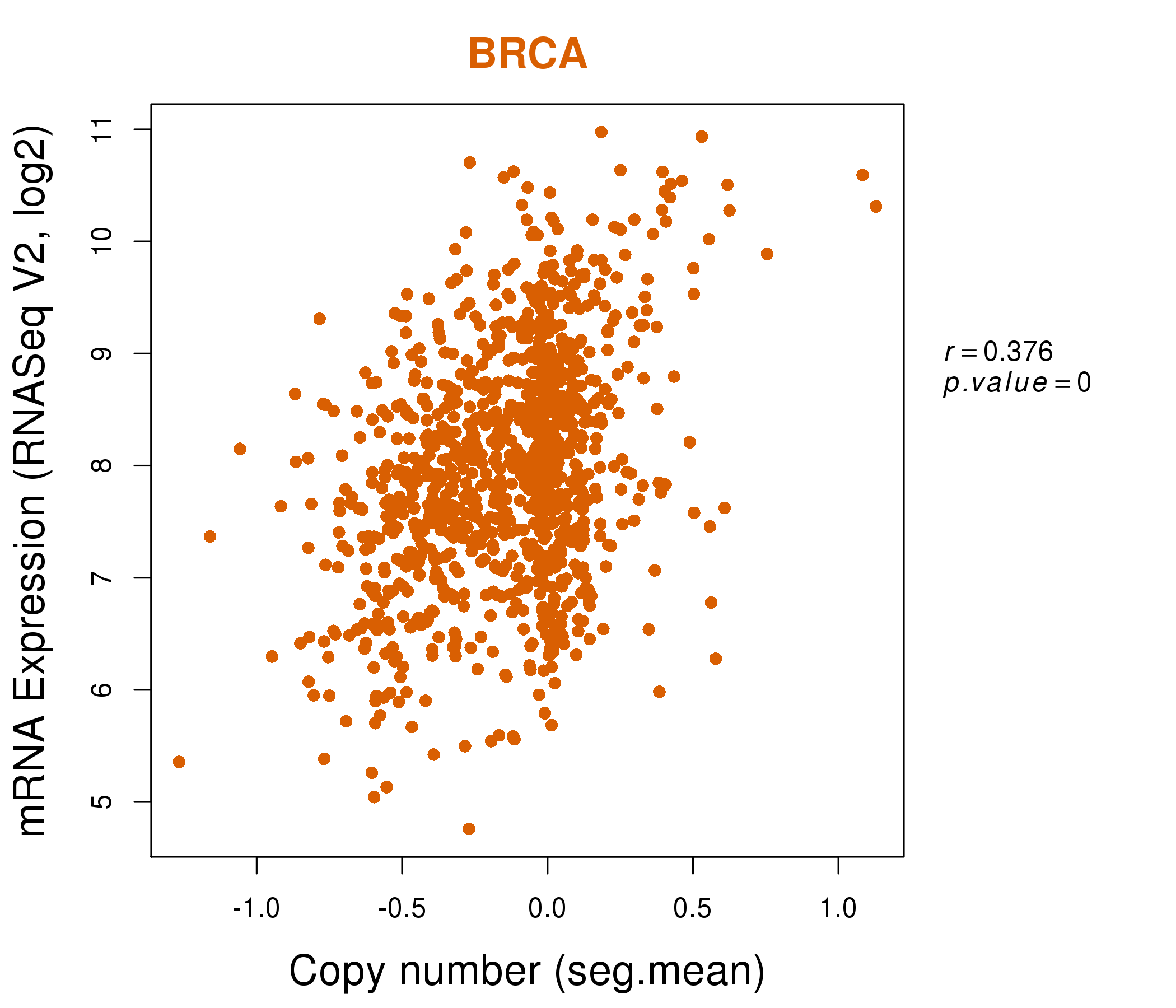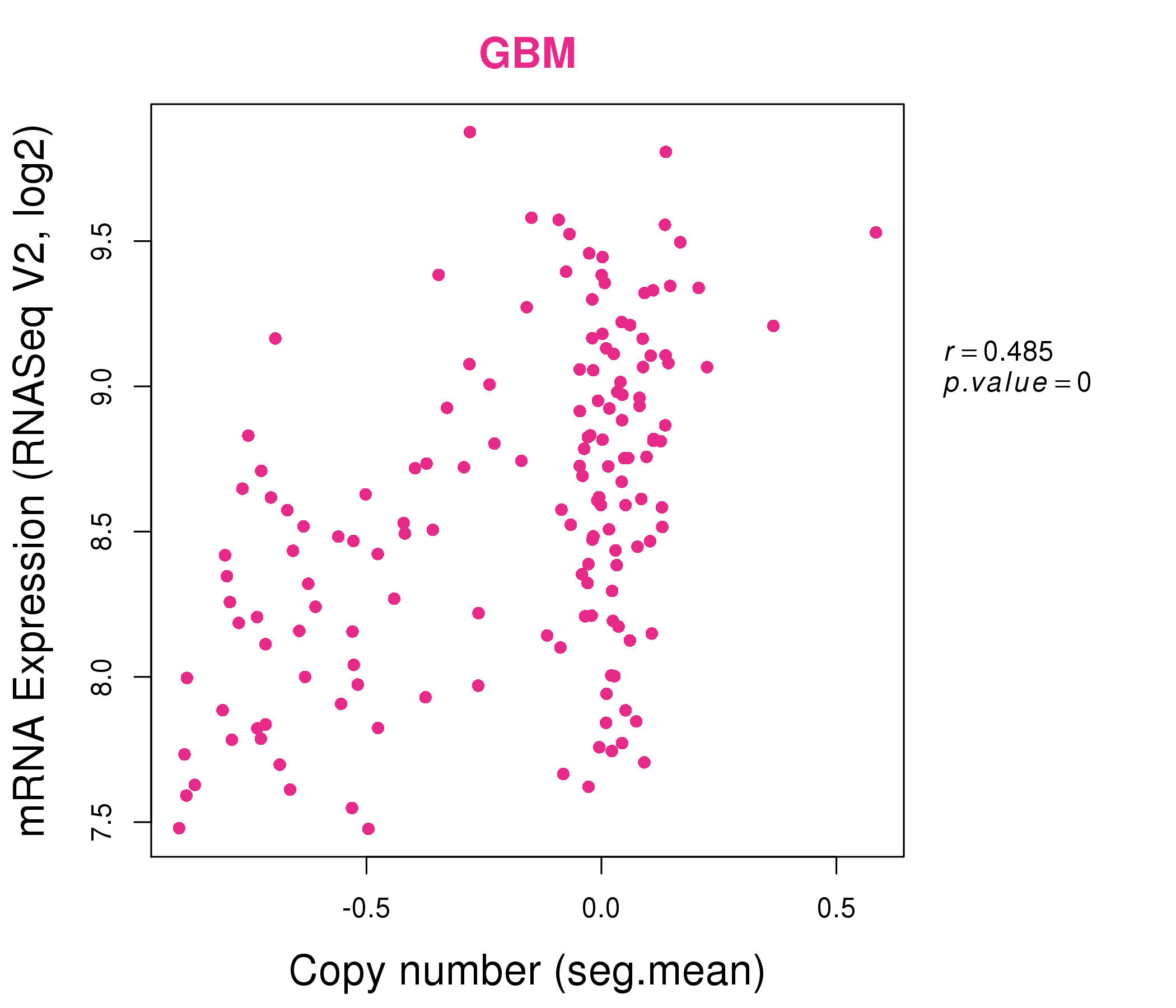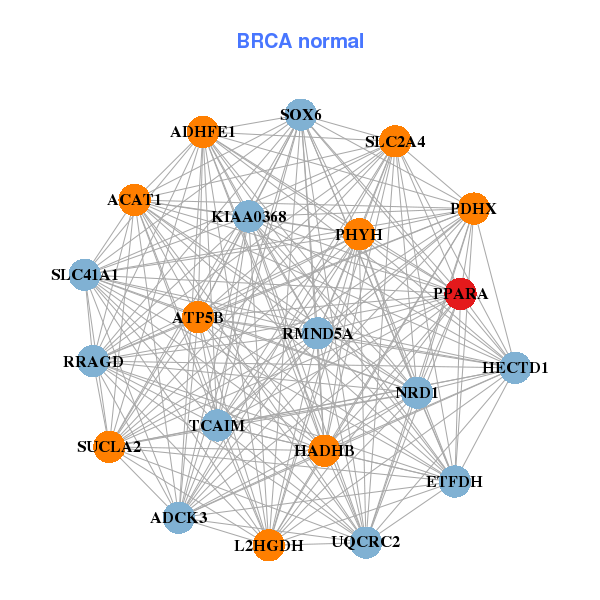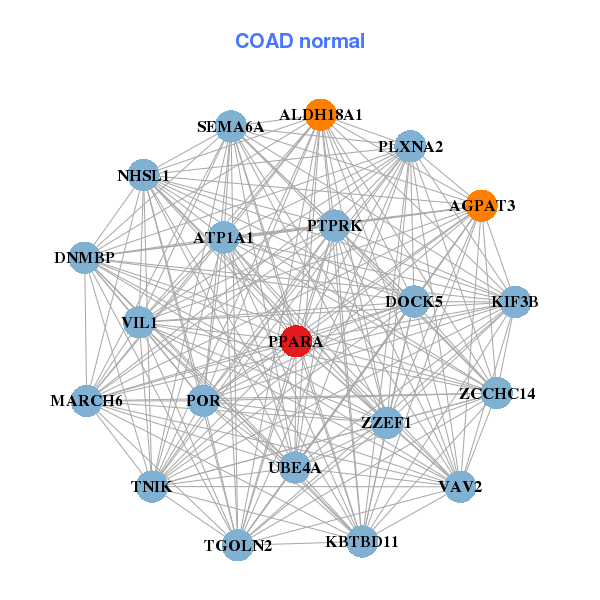|
||||||||||||||||||||||||||||||||||||||||||||||||||||||||||||||||||||||||||||||||||||||||||||||||||||||||||||||||||||||||||||||||||||||||||||||||||||||||||||||||||||||||||||||||||||||||||||||||||||||||||||||||||||||||||||||||||||||||||||||||||||||||||||||||||||||||||||||||||||||||||||||||||||||||||||||||||||||||||||||||||||||||||||||||||||||||||||||||||||||||||||||||||||||||||||||||||||||||||||
| |
| Phenotypic Information (metabolism pathway, cancer, disease, phenome) |
| |
| |
| Gene-Gene Network Information: Co-Expression Network, Interacting Genes & KEGG |
| |
|
| Gene Summary for PPARA |
| Basic gene info. | Gene symbol | PPARA |
| Gene name | peroxisome proliferator-activated receptor alpha | |
| Synonyms | NR1C1|PPAR|PPARalpha|hPPAR | |
| Cytomap | UCSC genome browser: 22q13.31 | |
| Genomic location | chr22 :46546498-46639653 | |
| Type of gene | protein-coding | |
| RefGenes | NM_001001928.2, NM_005036.4,NM_001001929.2,NM_001001930.2,NM_032644.3, | |
| Ensembl id | ENSG00000186951 | |
| Description | PPAR-alphanuclear receptor subfamily 1 group C member 1peroxisome proliferative activated receptor, alphaperoxisome proliferator-activated nuclear receptor alpha variant 3 | |
| Modification date | 20141222 | |
| dbXrefs | MIM : 170998 | |
| HGNC : HGNC | ||
| Ensembl : ENSG00000186951 | ||
| HPRD : 01369 | ||
| Vega : OTTHUMG00000150443 | ||
| Protein | UniProt: Q07869 go to UniProt's Cross Reference DB Table | |
| Expression | CleanEX: HS_PPARA | |
| BioGPS: 5465 | ||
| Gene Expression Atlas: ENSG00000186951 | ||
| The Human Protein Atlas: ENSG00000186951 | ||
| Pathway | NCI Pathway Interaction Database: PPARA | |
| KEGG: PPARA | ||
| REACTOME: PPARA | ||
| ConsensusPathDB | ||
| Pathway Commons: PPARA | ||
| Metabolism | MetaCyc: PPARA | |
| HUMANCyc: PPARA | ||
| Regulation | Ensembl's Regulation: ENSG00000186951 | |
| miRBase: chr22 :46,546,498-46,639,653 | ||
| TargetScan: NM_001001928 | ||
| cisRED: ENSG00000186951 | ||
| Context | iHOP: PPARA | |
| cancer metabolism search in PubMed: PPARA | ||
| UCL Cancer Institute: PPARA | ||
| Assigned class in ccmGDB | A - This gene has a literature evidence and it belongs to cancer gene. | |
| References showing role of PPARA in cancer cell metabolism | 1. Wang W-LW, Welsh J, Tenniswood M (2013) 1, 25-Dihydroxyvitamin D 3 modulates lipid metabolism in prostate cancer cells through miRNA mediated regulation of PPARA. The Journal of steroid biochemistry and molecular biology 136: 247-251. go to article | |
| Top |
| Phenotypic Information for PPARA(metabolism pathway, cancer, disease, phenome) |
| Cancer | CGAP: PPARA |
| Familial Cancer Database: PPARA | |
| * This gene is included in those cancer gene databases. |
|
|
|
|
|
| . | ||||||||||||||||||||||||||||||||||||||||||||||||||||||||||||||||||||||||||||||||||||||||||||||||||||||||||||||||||||||||||||||||||||||||||||||||||||||||||||||||||||||||||||||||||||||||||||||||||||||||||||||||||||||||||||||||||||||||||||||||||||||||||||||||||||||||||||||||||||||||||||||||||||||||||||||||||||||||||||||||||||||||||||||||||||||||||||||||||||||||||||||||||||||||||||||||||||||
Oncogene 1 | Significant driver gene in | |||||||||||||||||||||||||||||||||||||||||||||||||||||||||||||||||||||||||||||||||||||||||||||||||||||||||||||||||||||||||||||||||||||||||||||||||||||||||||||||||||||||||||||||||||||||||||||||||||||||||||||||||||||||||||||||||||||||||||||||||||||||||||||||||||||||||||||||||||||||||||||||||||||||||||||||||||||||||||||||||||||||||||||||||||||||||||||||||||||||||||||||||||||||||||||||||||||||||||
| cf) number; DB name 1 Oncogene; http://nar.oxfordjournals.org/content/35/suppl_1/D721.long, 2 Tumor Suppressor gene; https://bioinfo.uth.edu/TSGene/, 3 Cancer Gene Census; http://www.nature.com/nrc/journal/v4/n3/abs/nrc1299.html, 4 CancerGenes; http://nar.oxfordjournals.org/content/35/suppl_1/D721.long, 5 Network of Cancer Gene; http://ncg.kcl.ac.uk/index.php, 1Therapeutic Vulnerabilities in Cancer; http://cbio.mskcc.org/cancergenomics/statius/ |
| REACTOME_METABOLISM_OF_LIPIDS_AND_LIPOPROTEINS | |
| OMIM | 170998; gene+phenotype. |
| Orphanet | |
| Disease | KEGG Disease: PPARA |
| MedGen: PPARA (Human Medical Genetics with Condition) | |
| ClinVar: PPARA | |
| Phenotype | MGI: PPARA (International Mouse Phenotyping Consortium) |
| PhenomicDB: PPARA | |
| Mutations for PPARA |
| * Under tables are showing count per each tissue to give us broad intuition about tissue specific mutation patterns.You can go to the detailed page for each mutation database's web site. |
| - Statistics for Tissue and Mutation type | Top |
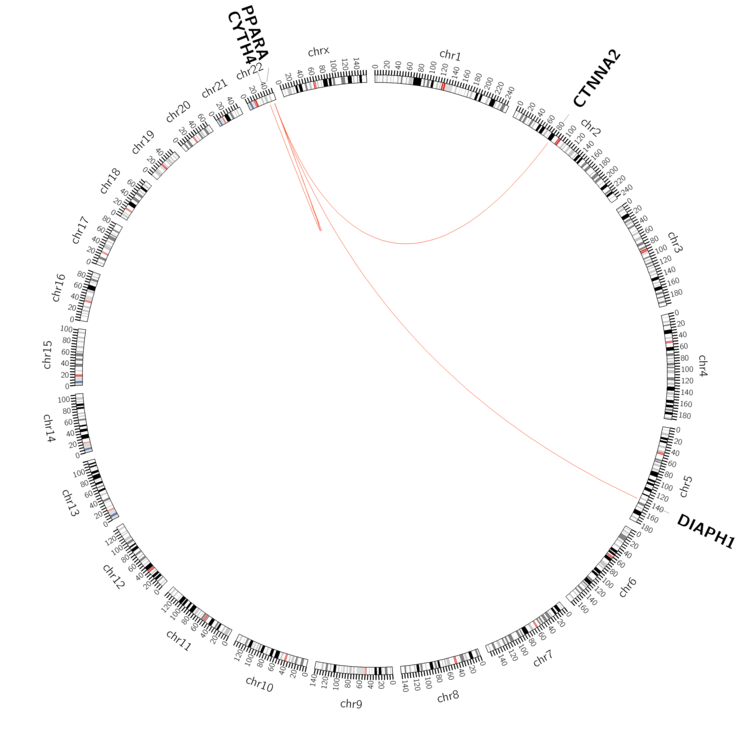 |
| - For Inter-chromosomal Variations |
| * Inter-chromosomal variantions includes 'interchromosomal amplicon to amplicon', 'interchromosomal amplicon to non-amplified dna', 'interchromosomal insertion', 'Interchromosomal unknown type'. |
 |
| - For Intra-chromosomal Variations |
| * Intra-chromosomal variantions includes 'intrachromosomal amplicon to amplicon', 'intrachromosomal amplicon to non-amplified dna', 'intrachromosomal deletion', 'intrachromosomal fold-back inversion', 'intrachromosomal inversion', 'intrachromosomal tandem duplication', 'Intrachromosomal unknown type', 'intrachromosomal with inverted orientation', 'intrachromosomal with non-inverted orientation'. |
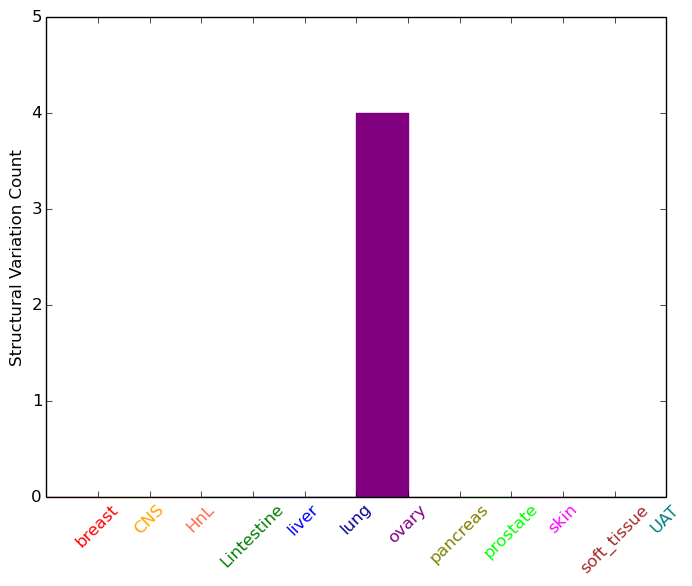 |
| Sample | Symbol_a | Chr_a | Start_a | End_a | Symbol_b | Chr_b | Start_b | End_b |
| ovary | PPARA | chr22 | 46572720 | 46572740 | chr22 | 46259135 | 46259155 | |
| ovary | PPARA | chr22 | 46579824 | 46579844 | CYTH4 | chr22 | 37699353 | 37699373 |
| ovary | PPARA | chr22 | 46598322 | 46598342 | chr22 | 46260488 | 46260508 | |
| ovary | PPARA | chr22 | 46634367 | 46634387 | PPARA | chr22 | 46634428 | 46634448 |
| cf) Tissue number; Tissue name (1;Breast, 2;Central_nervous_system, 3;Haematopoietic_and_lymphoid_tissue, 4;Large_intestine, 5;Liver, 6;Lung, 7;Ovary, 8;Pancreas, 9;Prostate, 10;Skin, 11;Soft_tissue, 12;Upper_aerodigestive_tract) |
| * From mRNA Sanger sequences, Chitars2.0 arranged chimeric transcripts. This table shows PPARA related fusion information. |
| ID | Head Gene | Tail Gene | Accession | Gene_a | qStart_a | qEnd_a | Chromosome_a | tStart_a | tEnd_a | Gene_a | qStart_a | qEnd_a | Chromosome_a | tStart_a | tEnd_a |
| BF911067 | PPARA | 4 | 96 | 22 | 46559133 | 46559225 | PPARA | 95 | 392 | 22 | 46553064 | 46553360 | |
| AA807786 | PPARA | 8 | 135 | 22 | 46637688 | 46637815 | PPARA | 133 | 454 | 22 | 46637369 | 46637692 | |
| AI079573 | PPARA | 1 | 164 | 22 | 46637648 | 46637811 | AP2M1 | 162 | 538 | 3 | 183901431 | 183901807 | |
| Top |
| Mutation type/ Tissue ID | brca | cns | cerv | endome | haematopo | kidn | Lintest | liver | lung | ns | ovary | pancre | prost | skin | stoma | thyro | urina | |||
| Total # sample | 2 | 1 | 2 | |||||||||||||||||
| GAIN (# sample) | 2 | |||||||||||||||||||
| LOSS (# sample) | 2 | 1 |
| cf) Tissue ID; Tissue type (1; Breast, 2; Central_nervous_system, 3; Cervix, 4; Endometrium, 5; Haematopoietic_and_lymphoid_tissue, 6; Kidney, 7; Large_intestine, 8; Liver, 9; Lung, 10; NS, 11; Ovary, 12; Pancreas, 13; Prostate, 14; Skin, 15; Stomach, 16; Thyroid, 17; Urinary_tract) |
| Top |
|
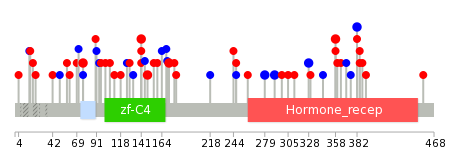 |
| Top |
| Stat. for Non-Synonymous SNVs (# total SNVs=26) | (# total SNVs=15) |
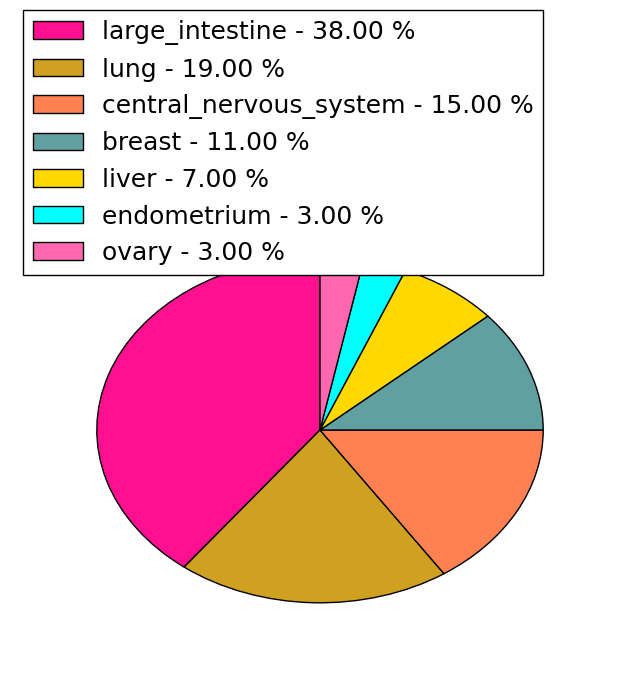 | 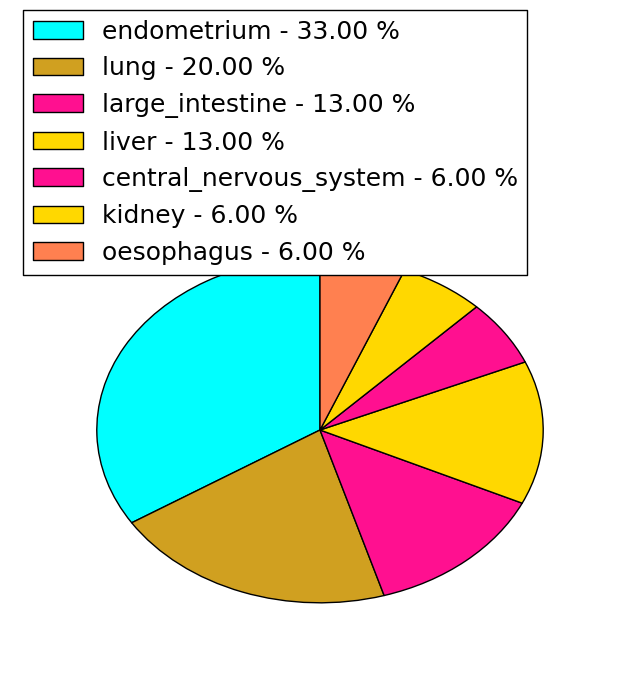 |
(# total SNVs=4) | (# total SNVs=0) |
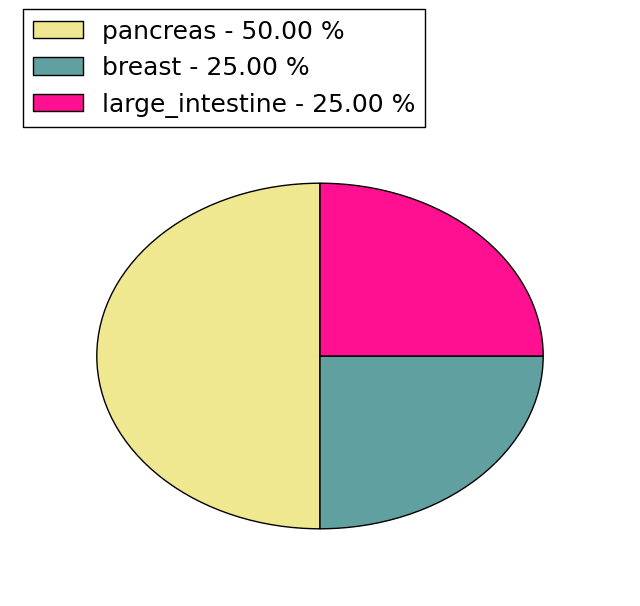 |
| Top |
| * When you move the cursor on each content, you can see more deailed mutation information on the Tooltip. Those are primary_site,primary_histology,mutation(aa),pubmedID. |
| GRCh37 position | Mutation(aa) | Unique sampleID count |
| chr22:46614210-46614212 | p.R141delR | 2 |
| chr22:46614211-46614211 | p.R141C | 2 |
| chr22:46628123-46628123 | p.I382I | 2 |
| chr22:46627961-46627961 | p.D328D | 2 |
| chr22:46614234-46614234 | p.K148N | 2 |
| chr22:46628131-46628131 | p.C385S | 2 |
| chr22:46628050-46628050 | p.K358R | 2 |
| chr22:46611088-46611088 | p.S76L | 2 |
| chr22:46627814-46627814 | p.T279T | 2 |
| chr22:46615714-46615714 | p.R172C | 2 |
| Top |
|
 |
| Point Mutation/ Tissue ID | 1 | 2 | 3 | 4 | 5 | 6 | 7 | 8 | 9 | 10 | 11 | 12 | 13 | 14 | 15 | 16 | 17 | 18 | 19 | 20 |
| # sample | 1 | 7 | 1 | 1 | 3 | 2 | 1 | 14 | 4 | 1 | 5 | |||||||||
| # mutation | 1 | 7 | 1 | 1 | 3 | 2 | 1 | 13 | 4 | 1 | 6 | |||||||||
| nonsynonymous SNV | 1 | 5 | 1 | 1 | 1 | 1 | 7 | 3 | 1 | 1 | ||||||||||
| synonymous SNV | 2 | 1 | 2 | 1 | 6 | 1 | 5 |
| cf) Tissue ID; Tissue type (1; BLCA[Bladder Urothelial Carcinoma], 2; BRCA[Breast invasive carcinoma], 3; CESC[Cervical squamous cell carcinoma and endocervical adenocarcinoma], 4; COAD[Colon adenocarcinoma], 5; GBM[Glioblastoma multiforme], 6; Glioma Low Grade, 7; HNSC[Head and Neck squamous cell carcinoma], 8; KICH[Kidney Chromophobe], 9; KIRC[Kidney renal clear cell carcinoma], 10; KIRP[Kidney renal papillary cell carcinoma], 11; LAML[Acute Myeloid Leukemia], 12; LUAD[Lung adenocarcinoma], 13; LUSC[Lung squamous cell carcinoma], 14; OV[Ovarian serous cystadenocarcinoma ], 15; PAAD[Pancreatic adenocarcinoma], 16; PRAD[Prostate adenocarcinoma], 17; SKCM[Skin Cutaneous Melanoma], 18:STAD[Stomach adenocarcinoma], 19:THCA[Thyroid carcinoma], 20:UCEC[Uterine Corpus Endometrial Carcinoma]) |
| Top |
| * We represented just top 10 SNVs. When you move the cursor on each content, you can see more deailed mutation information on the Tooltip. Those are primary_site, primary_histology, mutation(aa), pubmedID. |
| Genomic Position | Mutation(aa) | Unique sampleID count |
| chr22:46611088 | p.S76L,PPARA | 2 |
| chr22:46627961 | p.D328D,PPARA | 2 |
| chr22:46615710 | p.G62D,PPARA | 1 |
| chr22:46594462 | p.H159Y,PPARA | 1 |
| chr22:46628055 | p.L370L,PPARA | 1 |
| chr22:46614165 | p.T69M,PPARA | 1 |
| chr22:46615854 | p.V164V,PPARA | 1 |
| chr22:46594465 | p.I375I,PPARA | 1 |
| chr22:46628087 | p.T71T,PPARA | 1 |
| chr22:46614173 | p.G165W,PPARA | 1 |
| * Copy number data were extracted from TCGA using R package TCGA-Assembler. The URLs of all public data files on TCGA DCC data server were gathered on Jan-05-2015. Function ProcessCNAData in TCGA-Assembler package was used to obtain gene-level copy number value which is calculated as the average copy number of the genomic region of a gene. |
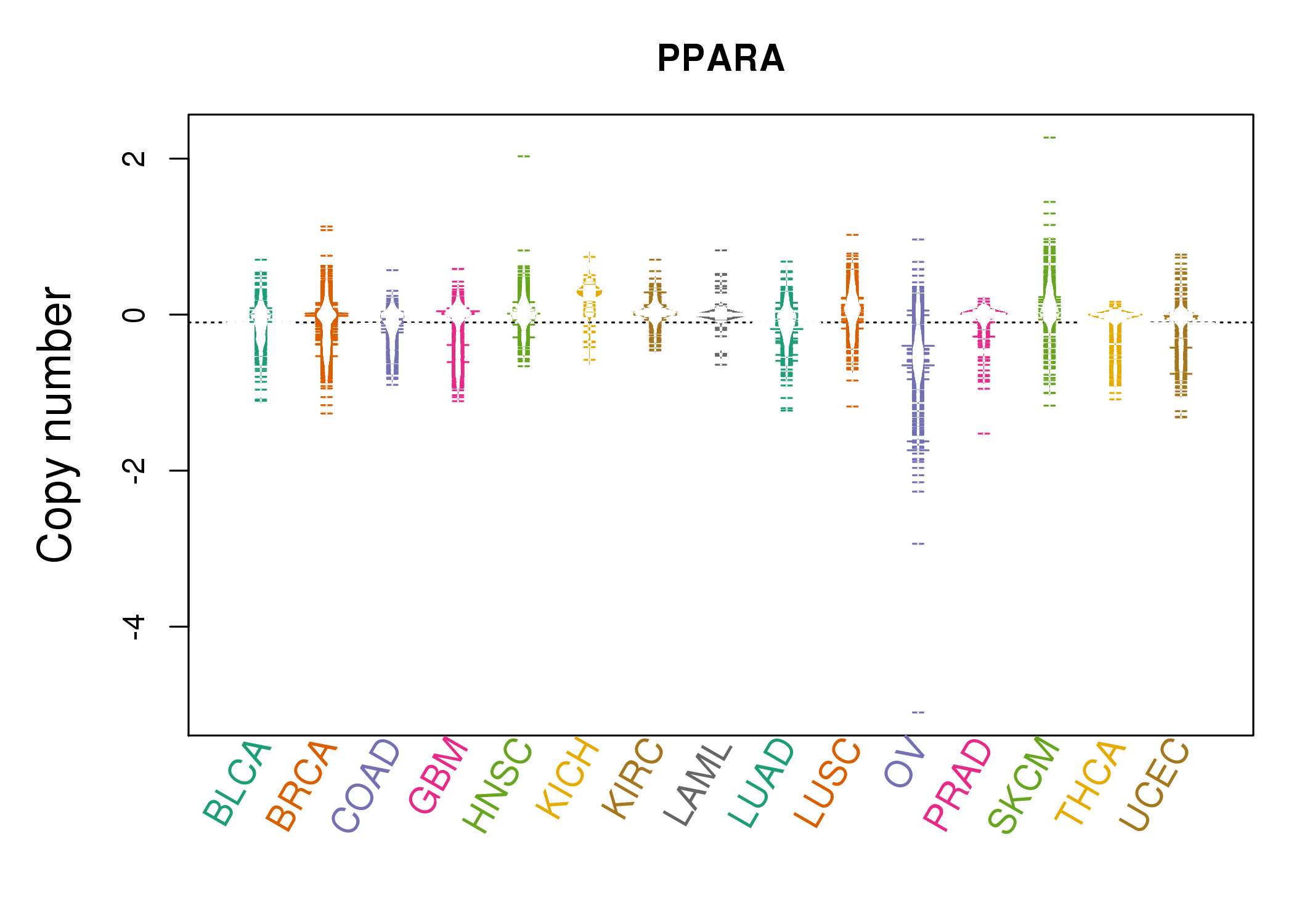 |
| cf) Tissue ID[Tissue type]: BLCA[Bladder Urothelial Carcinoma], BRCA[Breast invasive carcinoma], CESC[Cervical squamous cell carcinoma and endocervical adenocarcinoma], COAD[Colon adenocarcinoma], GBM[Glioblastoma multiforme], Glioma Low Grade, HNSC[Head and Neck squamous cell carcinoma], KICH[Kidney Chromophobe], KIRC[Kidney renal clear cell carcinoma], KIRP[Kidney renal papillary cell carcinoma], LAML[Acute Myeloid Leukemia], LUAD[Lung adenocarcinoma], LUSC[Lung squamous cell carcinoma], OV[Ovarian serous cystadenocarcinoma ], PAAD[Pancreatic adenocarcinoma], PRAD[Prostate adenocarcinoma], SKCM[Skin Cutaneous Melanoma], STAD[Stomach adenocarcinoma], THCA[Thyroid carcinoma], UCEC[Uterine Corpus Endometrial Carcinoma] |
| Top |
| Gene Expression for PPARA |
| * CCLE gene expression data were extracted from CCLE_Expression_Entrez_2012-10-18.res: Gene-centric RMA-normalized mRNA expression data. |
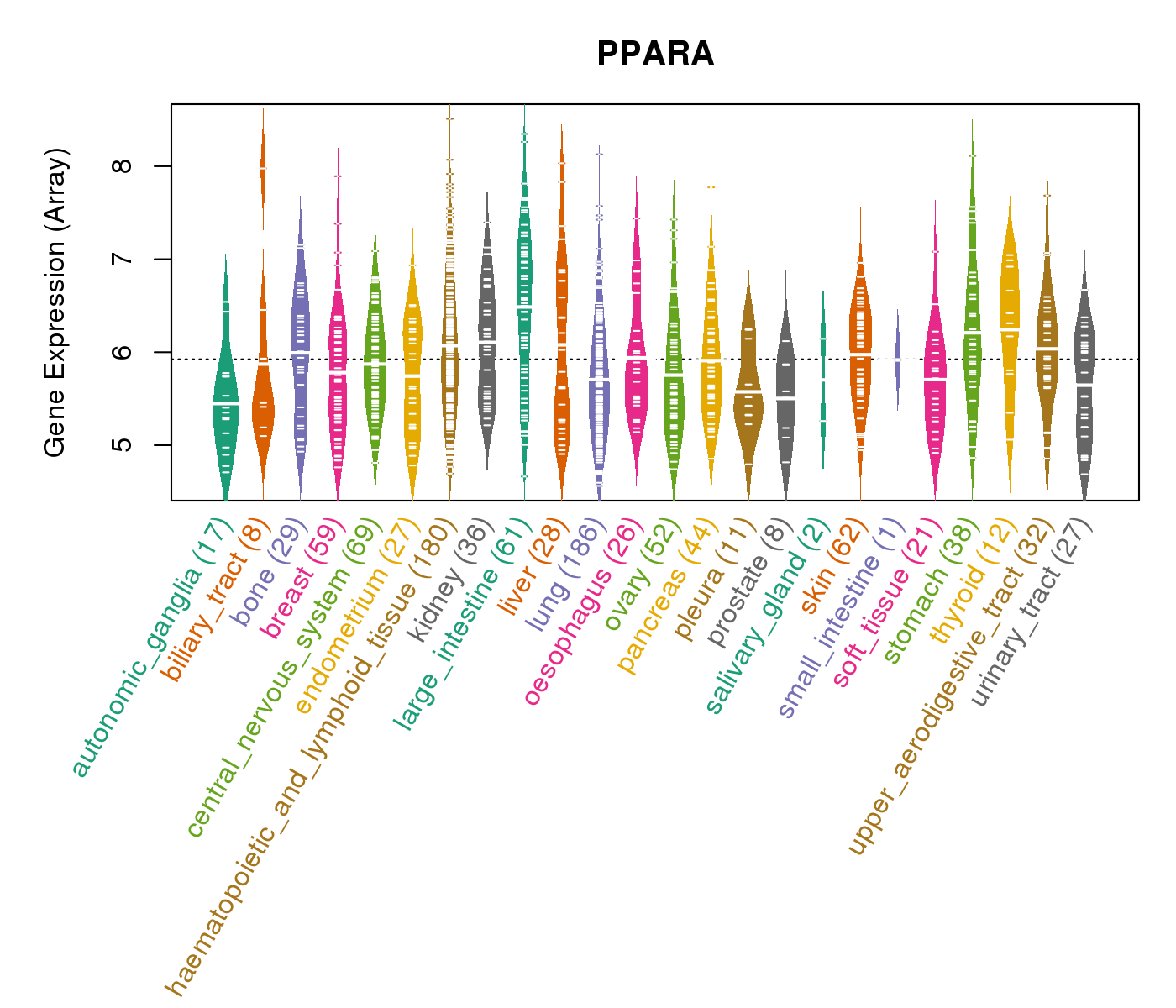 |
| * Normalized gene expression data of RNASeqV2 was extracted from TCGA using R package TCGA-Assembler. The URLs of all public data files on TCGA DCC data server were gathered at Jan-05-2015. Only eight cancer types have enough normal control samples for differential expression analysis. (t test, adjusted p<0.05 (using Benjamini-Hochberg FDR)) |
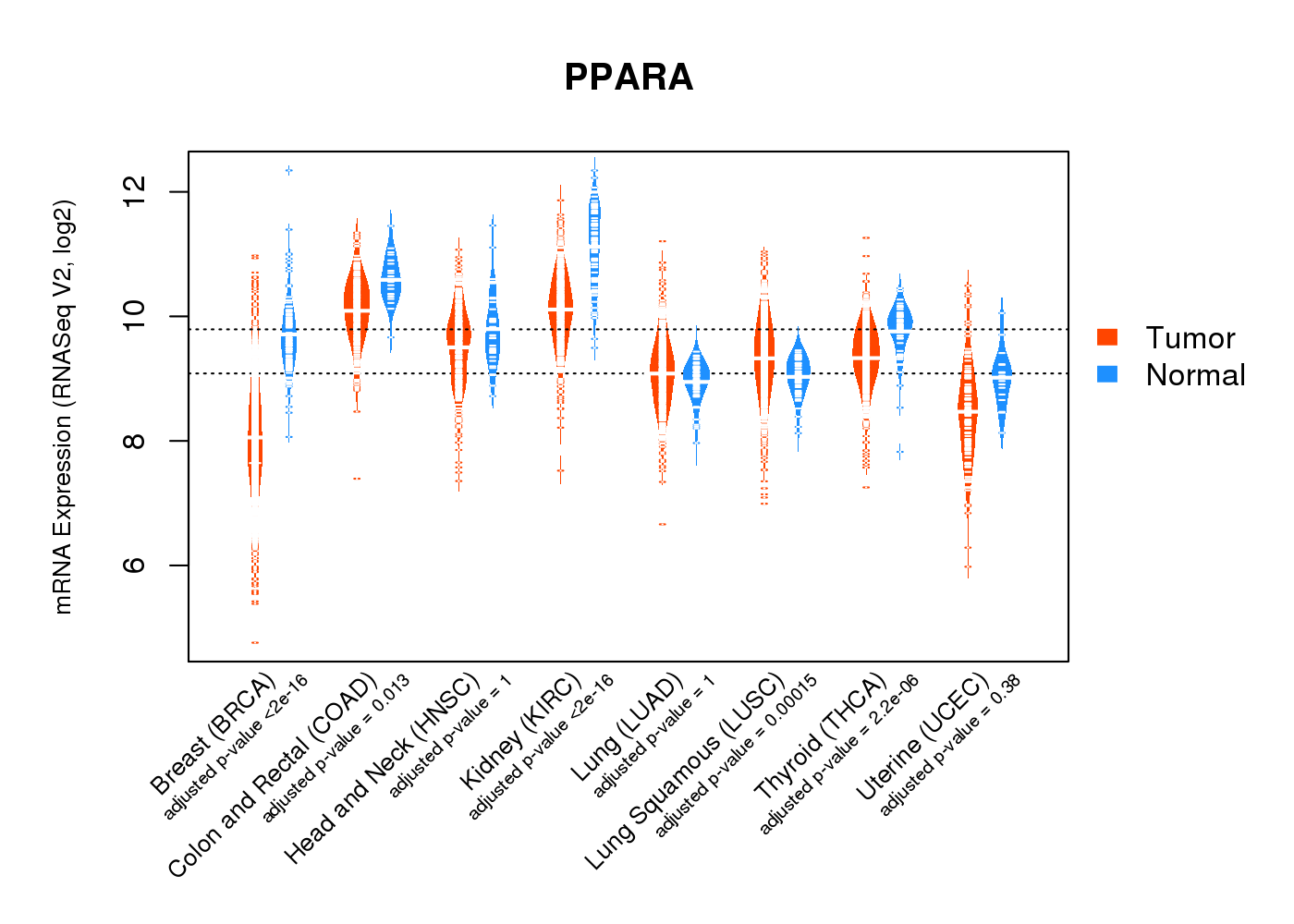 |
| Top |
| * This plots show the correlation between CNV and gene expression. |
: Open all plots for all cancer types
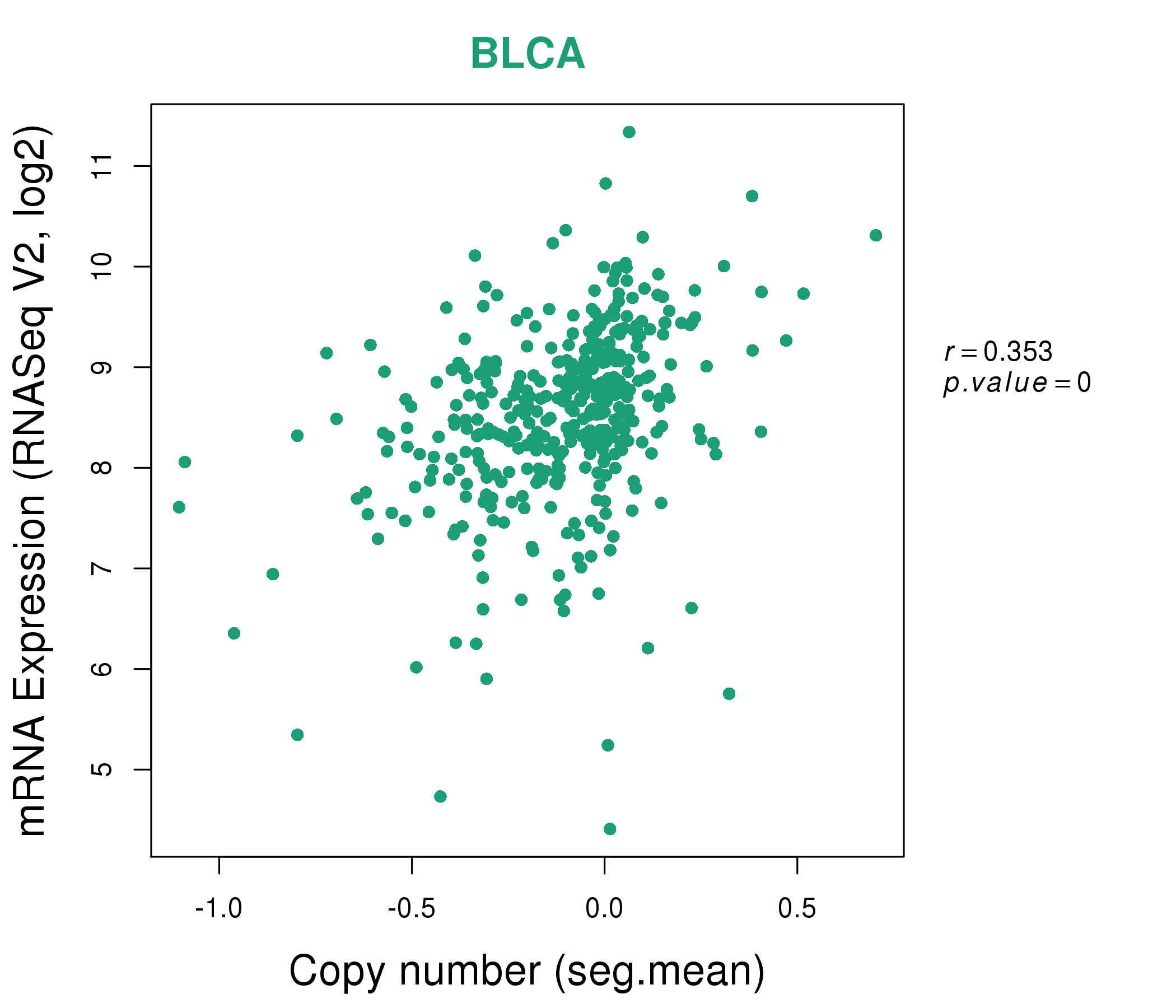 |
|
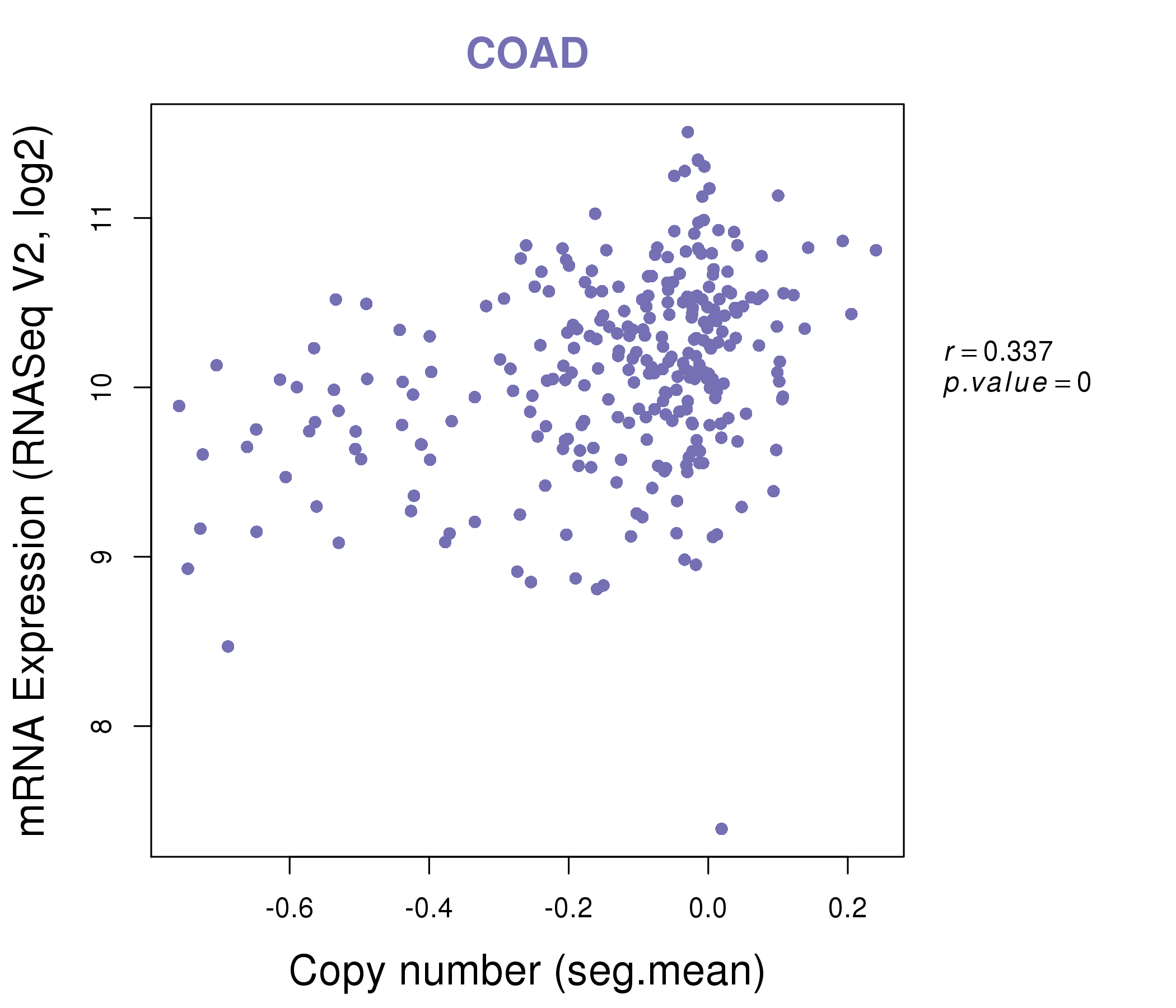 |
|
| Top |
| Gene-Gene Network Information |
| * Co-Expression network figures were drawn using R package igraph. Only the top 20 genes with the highest correlations were shown. Red circle: input gene, orange circle: cell metabolism gene, sky circle: other gene |
: Open all plots for all cancer types
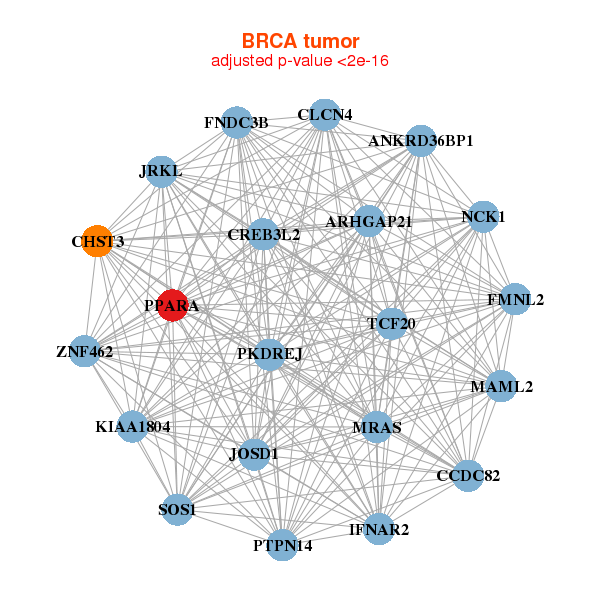 |
| ||||
| ANKRD36BP1,ARHGAP21,CCDC82,CHST3,CLCN4,CREB3L2,FMNL2, FNDC3B,IFNAR2,JOSD1,JRKL,KIAA1804,MAML2,MRAS, NCK1,PKDREJ,PPARA,PTPN14,SOS1,TCF20,ZNF462 | ACAT1,ADHFE1,ATP5B,TCAIM,ADCK3,ETFDH,HADHB, HECTD1,KIAA0368,L2HGDH,NRD1,PDHX,PHYH,PPARA, RMND5A,RRAGD,SLC2A4,SLC41A1,SOX6,SUCLA2,UQCRC2 | ||||
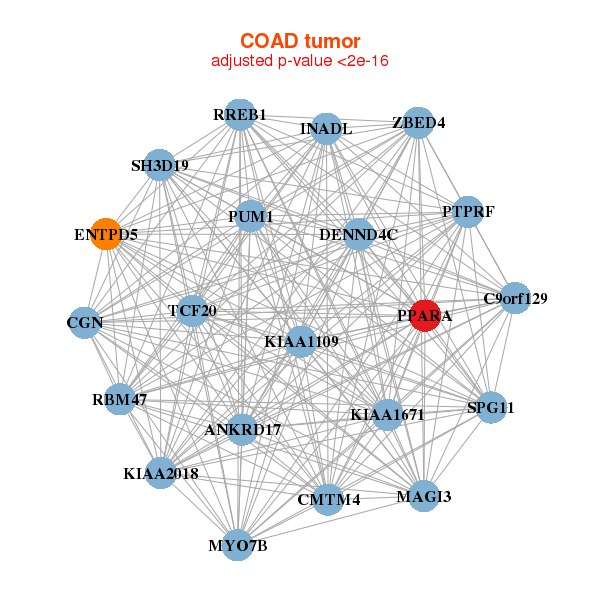 |
| ||||
| ANKRD17,C9orf129,CGN,CMTM4,DENND4C,ENTPD5,INADL, KIAA1109,KIAA1671,KIAA2018,MAGI3,MYO7B,PPARA,PTPRF, PUM1,RBM47,RREB1,SH3D19,SPG11,TCF20,ZBED4 | AGPAT3,ALDH18A1,ATP1A1,DNMBP,DOCK5,KBTBD11,KIF3B, MARCH6,NHSL1,PLXNA2,POR,PPARA,PTPRK,SEMA6A, TGOLN2,TNIK,UBE4A,VAV2,VIL1,ZCCHC14,ZZEF1 |
| * Co-Expression network figures were drawn using R package igraph. Only the top 20 genes with the highest correlations were shown. Red circle: input gene, orange circle: cell metabolism gene, sky circle: other gene |
: Open all plots for all cancer types
| Top |
: Open all interacting genes' information including KEGG pathway for all interacting genes from DAVID
| Top |
| Pharmacological Information for PPARA |
| DB Category | DB Name | DB's ID and Url link |
| Chemistry | BindingDB | Q07869; -. |
| Chemistry | ChEMBL | CHEMBL239; -. |
| Chemistry | GuidetoPHARMACOLOGY | 593; -. |
| Organism-specific databases | PharmGKB | PA280; -. |
| Organism-specific databases | CTD | 5465; -. |
| * Gene Centered Interaction Network. |
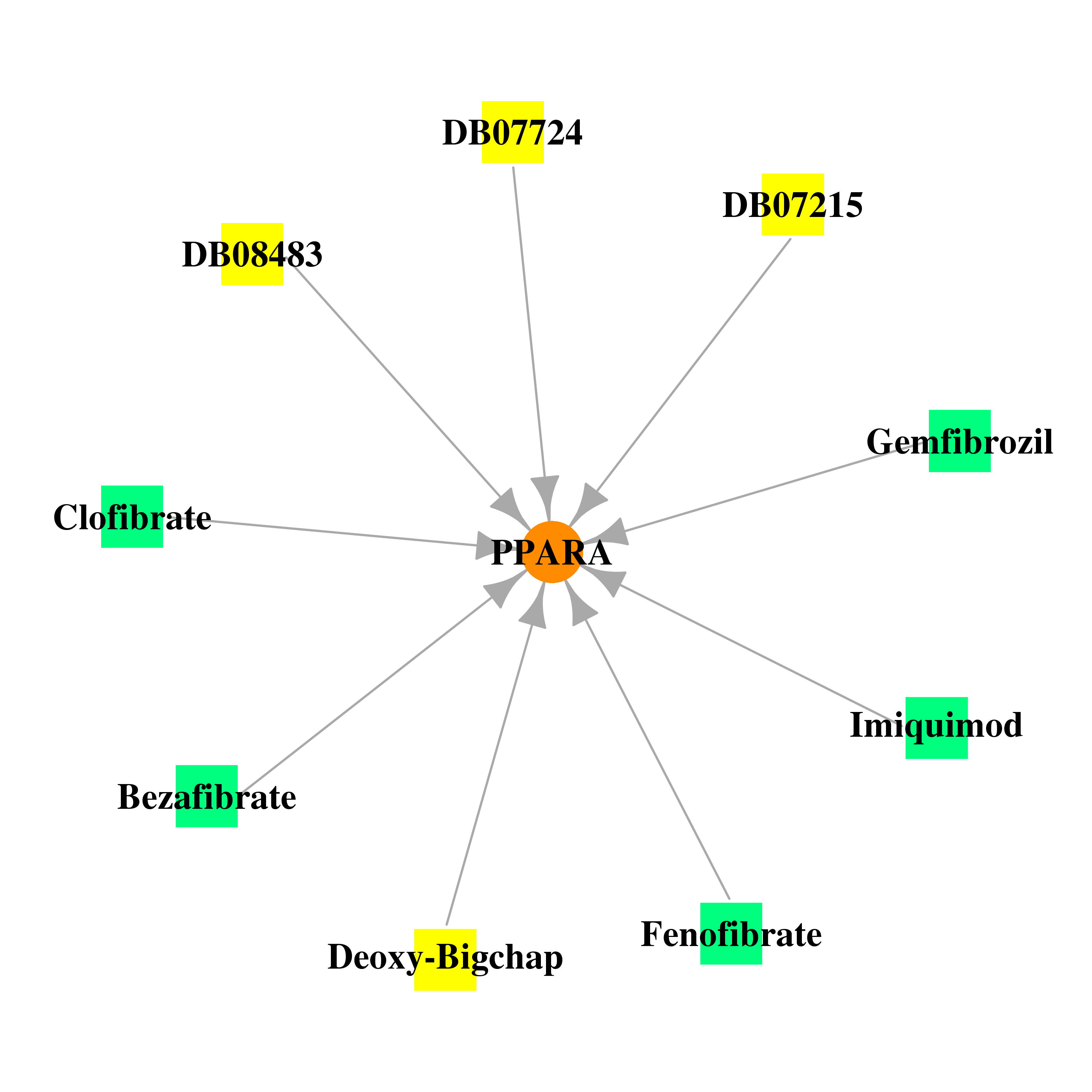 |
| * Drug Centered Interaction Network. |
| DrugBank ID | Target Name | Drug Groups | Generic Name | Drug Centered Network | Drug Structure |
| DB00636 | peroxisome proliferator-activated receptor alpha | approved | Clofibrate |  | 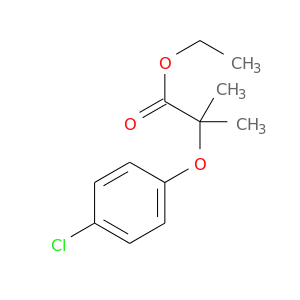 |
| DB01039 | peroxisome proliferator-activated receptor alpha | approved | Fenofibrate | 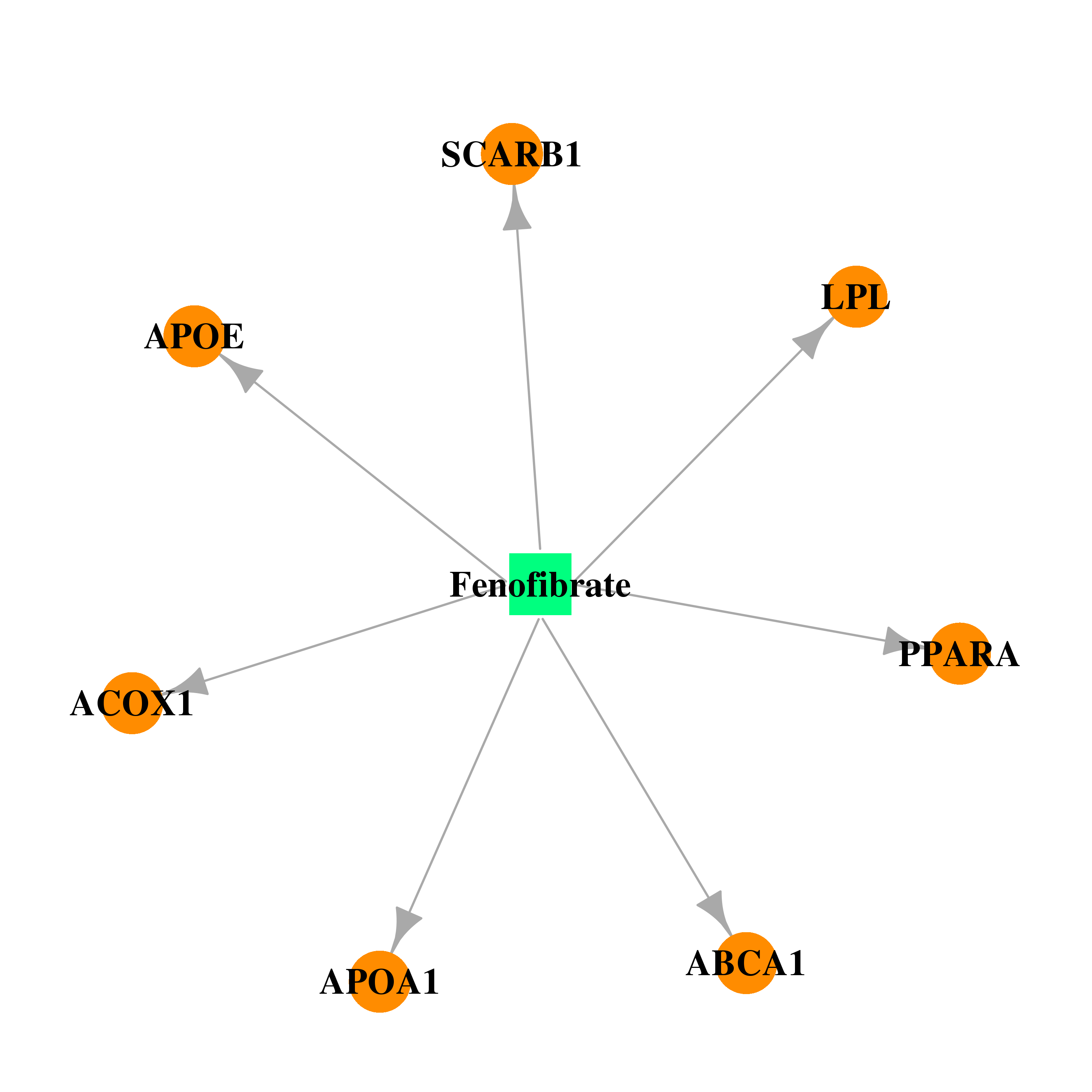 | 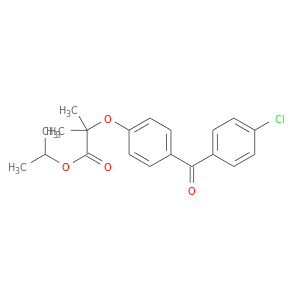 |
| DB01241 | peroxisome proliferator-activated receptor alpha | approved | Gemfibrozil | 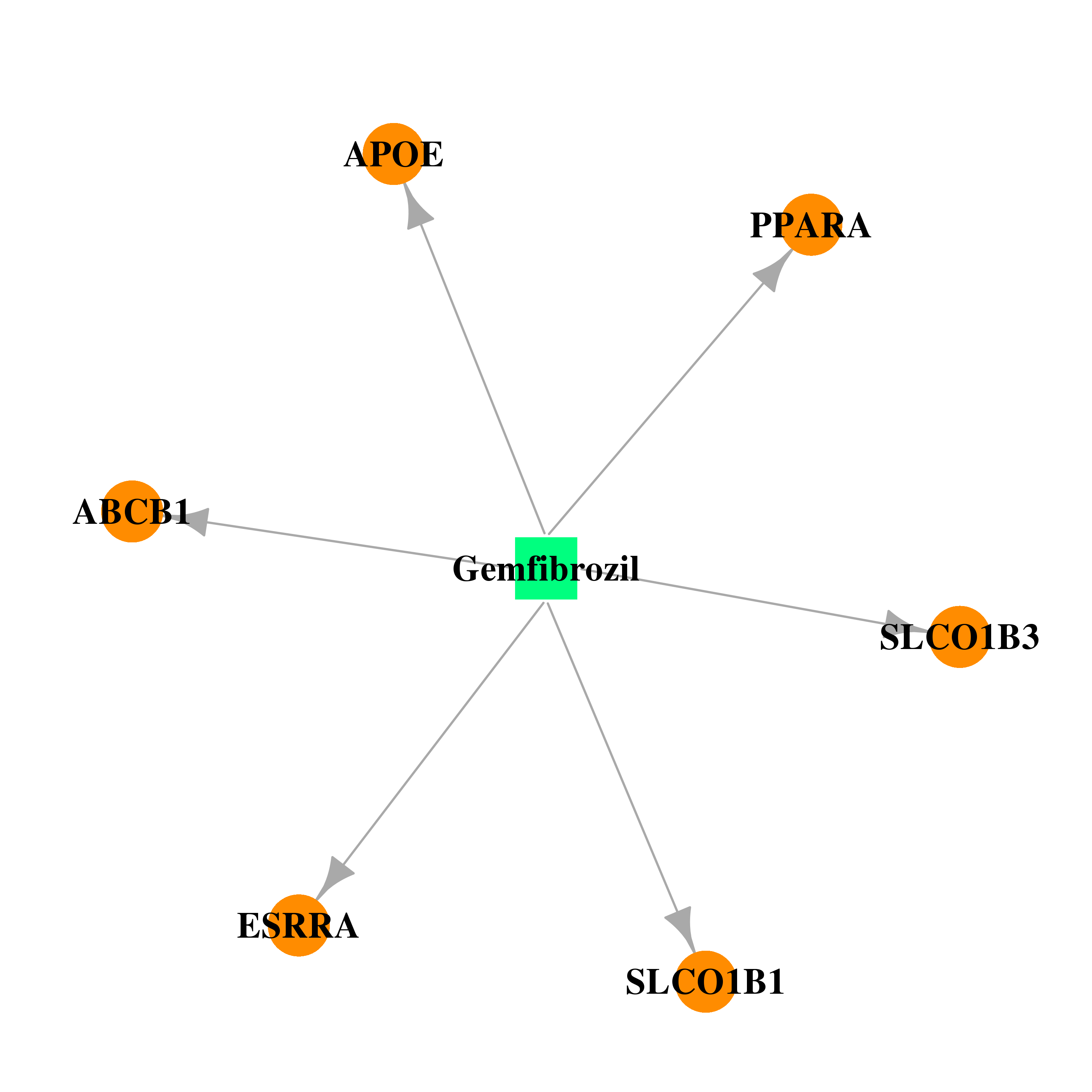 | 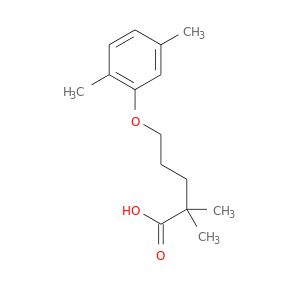 |
| DB01393 | peroxisome proliferator-activated receptor alpha | approved | Bezafibrate | 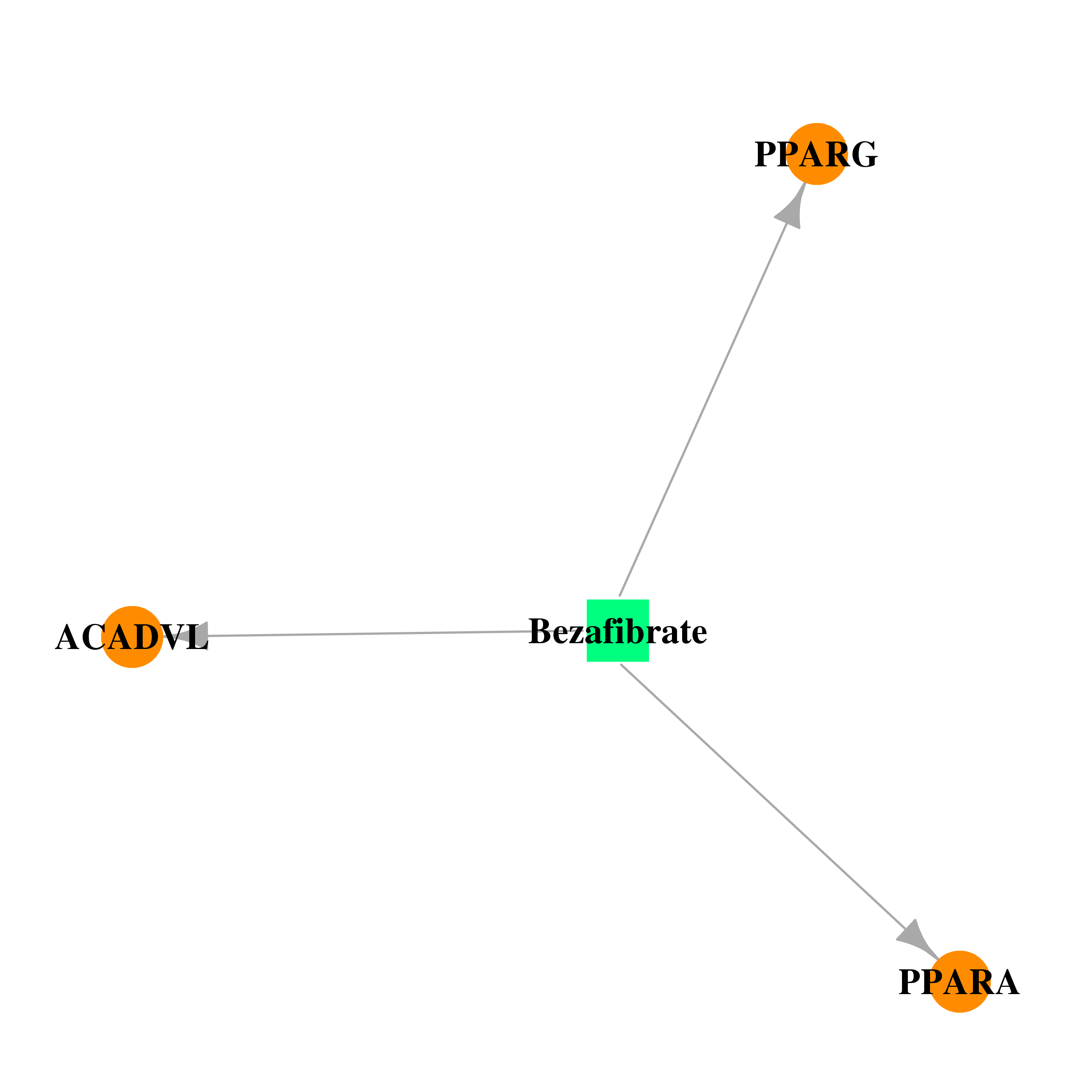 | 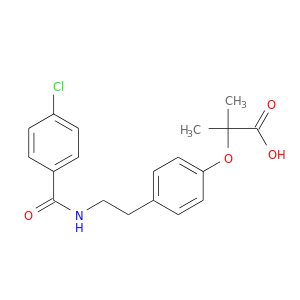 |
| DB01890 | peroxisome proliferator-activated receptor alpha | experimental | Deoxy-Bigchap |  | 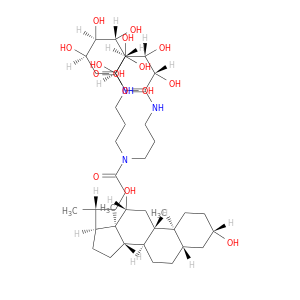 |
| DB07215 | peroxisome proliferator-activated receptor alpha | experimental | 2-METHYL-2-(4-{[({4-METHYL-2-[4-(TRIFLUOROMETHYL)PHENYL]-1,3-THIAZOL-5-YL}CARBONYL)AMINO]METHYL}PHENOXY)PROPANOIC ACID |  | 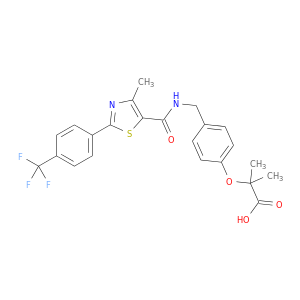 |
| DB07724 | peroxisome proliferator-activated receptor alpha | experimental | 3-{5-methoxy-1-[(4-methoxyphenyl)sulfonyl]-1H-indol-3-yl}propanoic acid | 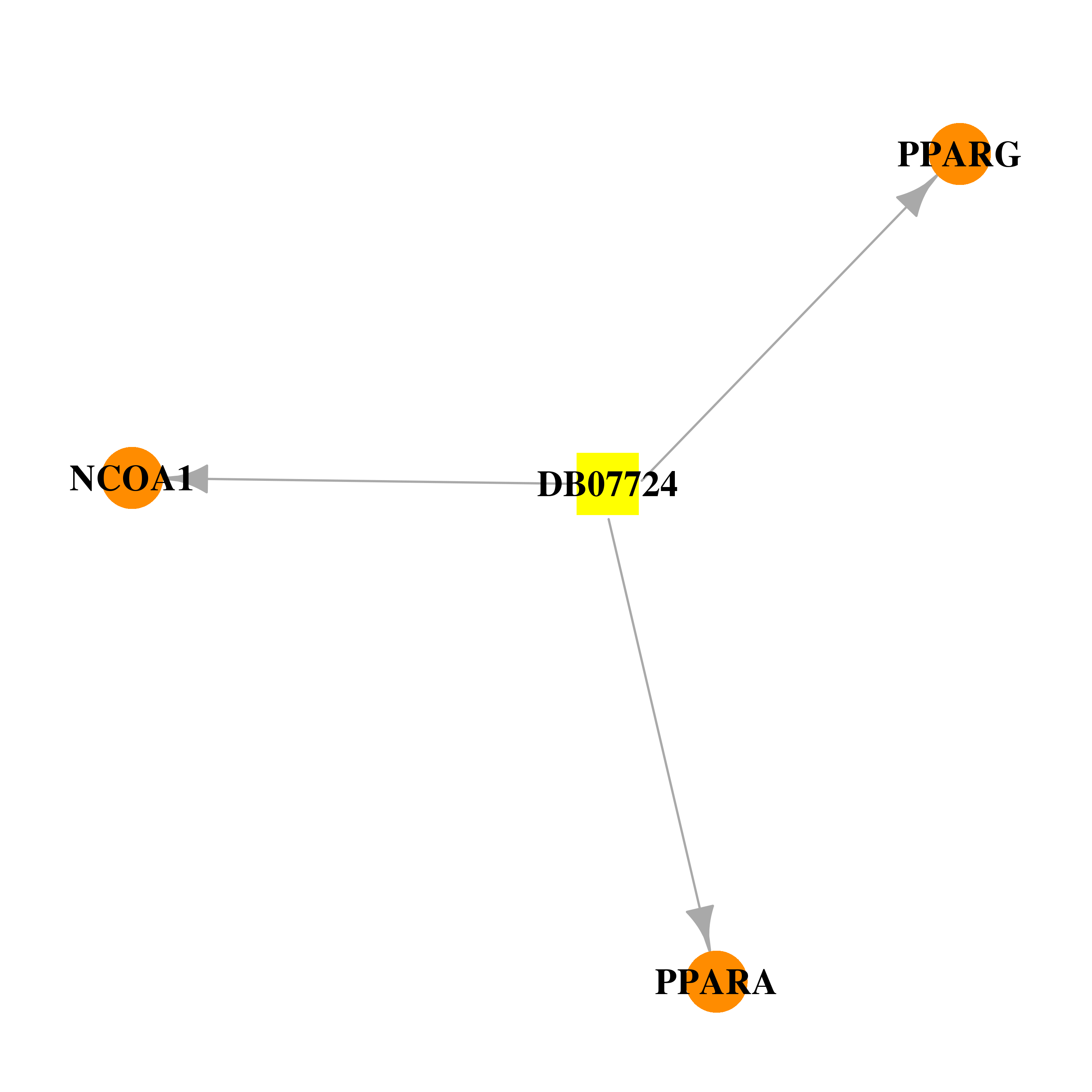 | 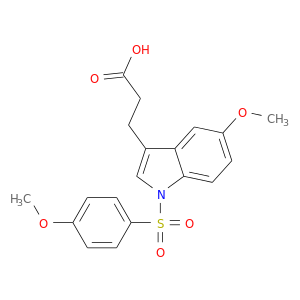 |
| DB08483 | peroxisome proliferator-activated receptor alpha | experimental | (2S)-2-methoxy-3-{4-[2-(5-methyl-2-phenyl-1,3-oxazol-4-yl)ethoxy]-1-benzothiophen-7-yl}propanoic acid | 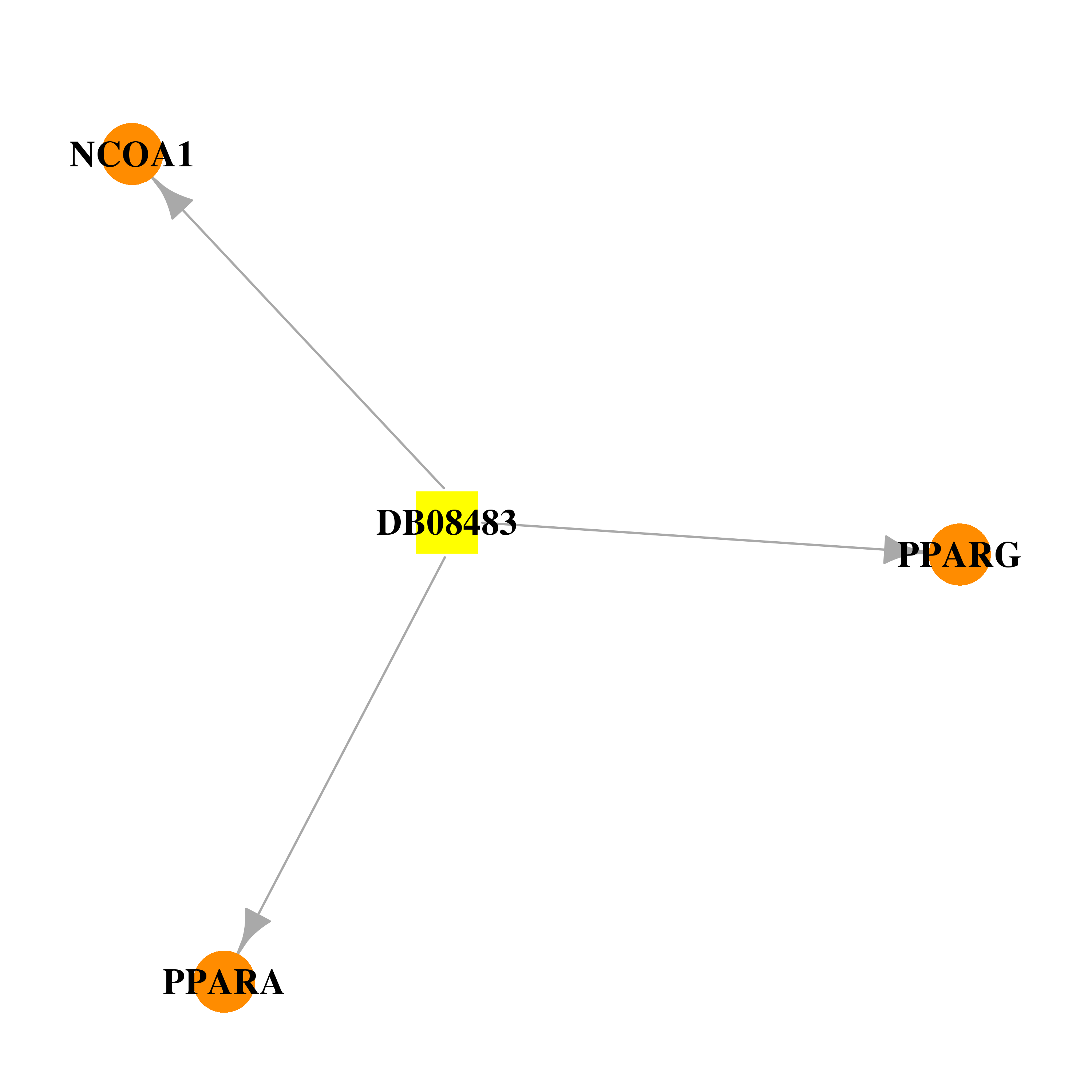 |  |
| DB00724 | peroxisome proliferator-activated receptor alpha | approved; investigational | Imiquimod | 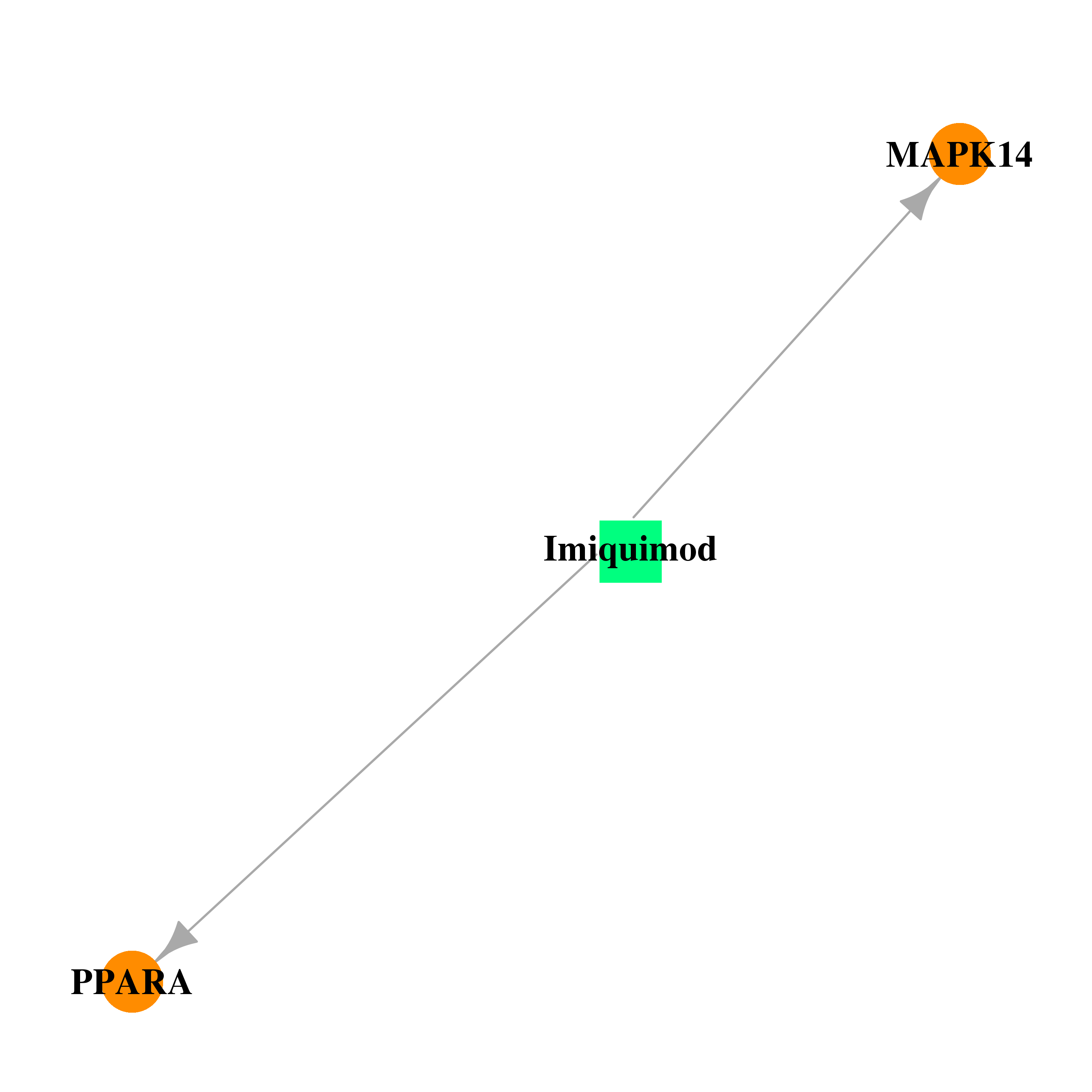 | 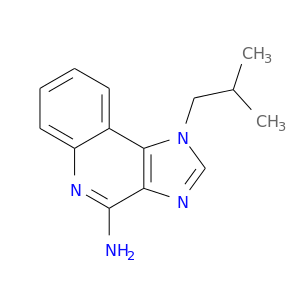 |
| Top |
| Cross referenced IDs for PPARA |
| * We obtained these cross-references from Uniprot database. It covers 150 different DBs, 18 categories. http://www.uniprot.org/help/cross_references_section |
: Open all cross reference information
|
Copyright © 2016-Present - The Univsersity of Texas Health Science Center at Houston @ |






